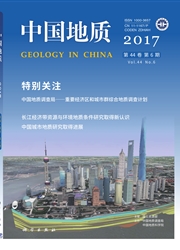

 中文摘要:
中文摘要:
阿克希克铁金矿床位于准噶尔北缘,矿体呈似层状、脉状、透镜状赋存于南明水组火山岩及凝灰岩的接触带上。围岩蚀变不发育,主要为硅化、绢云母化、绿泥石化、黄铁矿化、碳酸盐化等。矿床的形成经历了火山沉积期和热液期,铁矿化主要形成于火山沉积期,金矿化主要形成于热液期。火山沉积期石英以发育液体包裹体和少量含CO2包裹体为特征,热液期石英以发育含CO2和碳质(CH4和C4H6)包裹体为特征。火山沉积期成矿流体为中温(集中于180-320℃)、低盐度(集中于6-10 wt%Na Cleq)、中-低密度(0.59-0.98 g/cm^3)的Na Cl-H2O-CO2体系。热液期成矿流体为中温(集中于220-320℃),低盐度(集中于2-10 wt%Na Cleq),中-低密度(0.55-1.03 g/cm^3)的Na Cl-H2O-CO2-CH4型流体。火山沉积期石英的δDSMOW为-129.9‰--97.9‰,δ^18OSMOW值介于7.9‰-12.3‰,δ^18OH2O值为-2.6‰-4.4‰,推测成矿流体为海水与岩浆水的混合。热液期石英的δDSMOW介于-129.8‰--102.6‰,δ^18OSMOW值介于11.2‰-16.1‰,δ^18OH2O变化于3.1‰-7.4‰,推测成矿流体为变质水混合深循环的大气降水。结合矿床地质特征、流体成分和性质,本文认为热液期金矿化与CO2-CH4流体有关。
 英文摘要:
英文摘要:
The Akexike Fe- Au deposit on the northern margin of the Junggar Basin occurs in the contact zone between volcanic rocks and tufts of the Nanmingshui Formation. The orebodies are podiform, veined, and lenticular in form. The deposit has expereinced siliciflcation, sericitization, chloritization, pyritization and carbonatization. Field evidence and petrographic analysis indicate two periods of metallogenesis: the volcanic-sedimentary period associated with the development of Fe mineralization and the hydrothermal period associated with Au mineralization. Liquid- and a few CO2- rich inclusions characterize the volcanic- sedimentary period, whereas CO2- and carbon (CH4 and C4H6)-rich inclusions characterize the hydrothermal period. Volcanic- sedimentary period had NaCl-H2O-CO2 fluids with moderate temperature (major Th of 180-320 ℃), low salinity (mainly 6-10 wt% NaCleq), and modereate to low density (0.59-0.98 g/cm^3). Hydrothermal period has NaCl-H2O-CO2-CH4 fluids with moderate temperature (major Th of 220-320℃), low salinity ( mainly 2-10 wt% NaCleq), and moderate to low density (0.55-1.03 g/ cm^3). Stable isotope analysis of quartz yielded values of-129.9‰ to -97.9‰ for 079, 7.9‰ to 12.3‰ for δ^18OSMOW, and -2.6‰ to 4.4‰ for δ^18Ofluid, indicating that the ore-forming fluids were magmatic fluids mixed with seawater. δD, δ^18OSMOW, and δ^18Ofluid values of the hydrothermal period are- 129.8‰-102.6‰, 11.2‰- 16.1‰, and 3.1‰-7.4‰, respectively, indicating that the ore- forming fluids were metamorphic water mixed with deeply circulated meteoric water. Combined with geological characteristics and fluids composition, the authors hold that Au mineralization of hydrothermal period was closely associated with CO2-CH4 fluids.
 同期刊论文项目
同期刊论文项目
 同项目期刊论文
同项目期刊论文
 期刊信息
期刊信息
